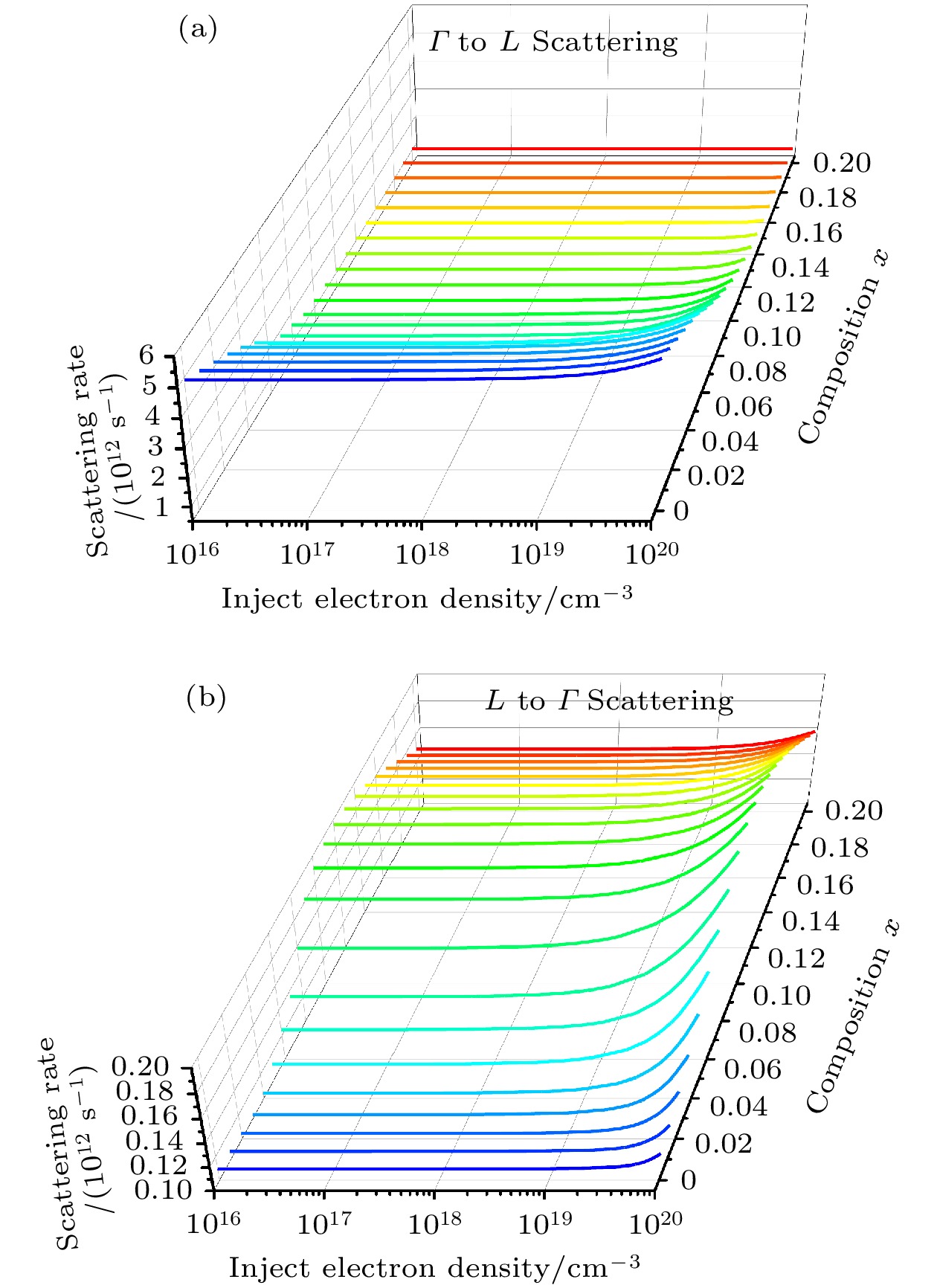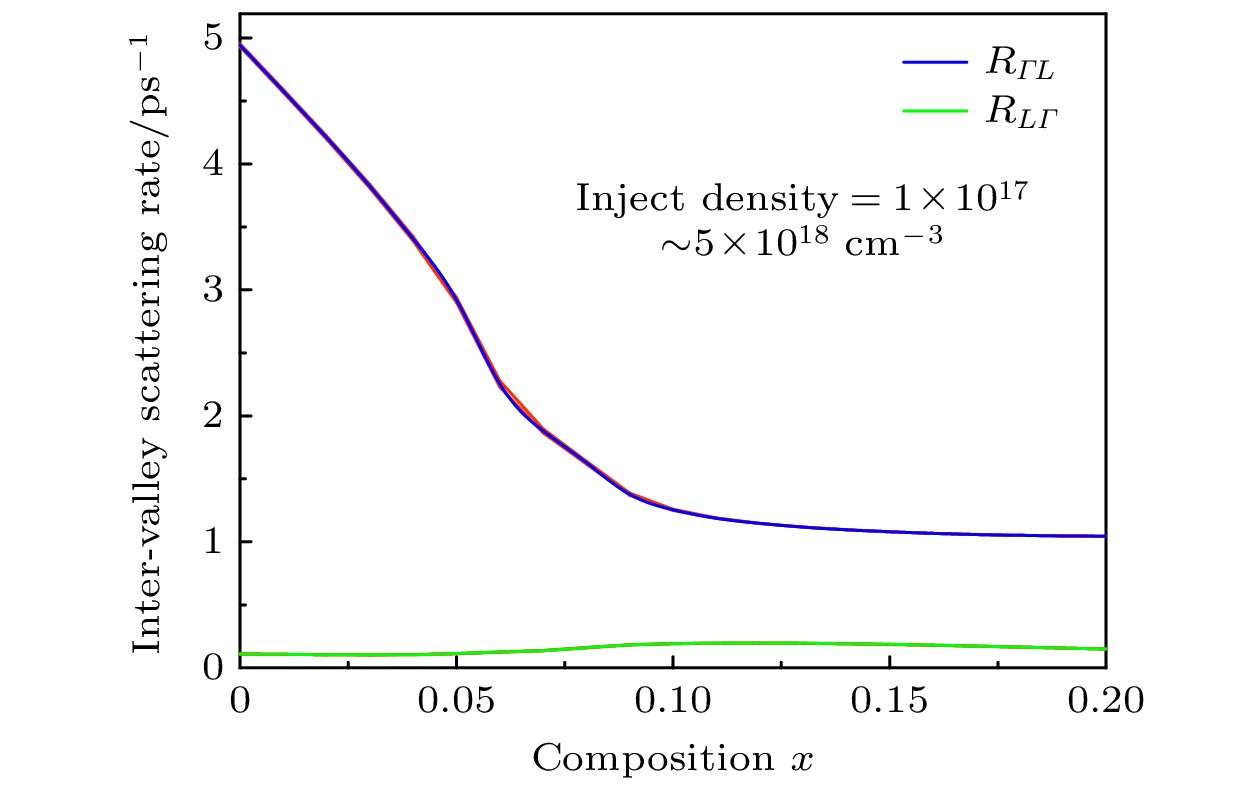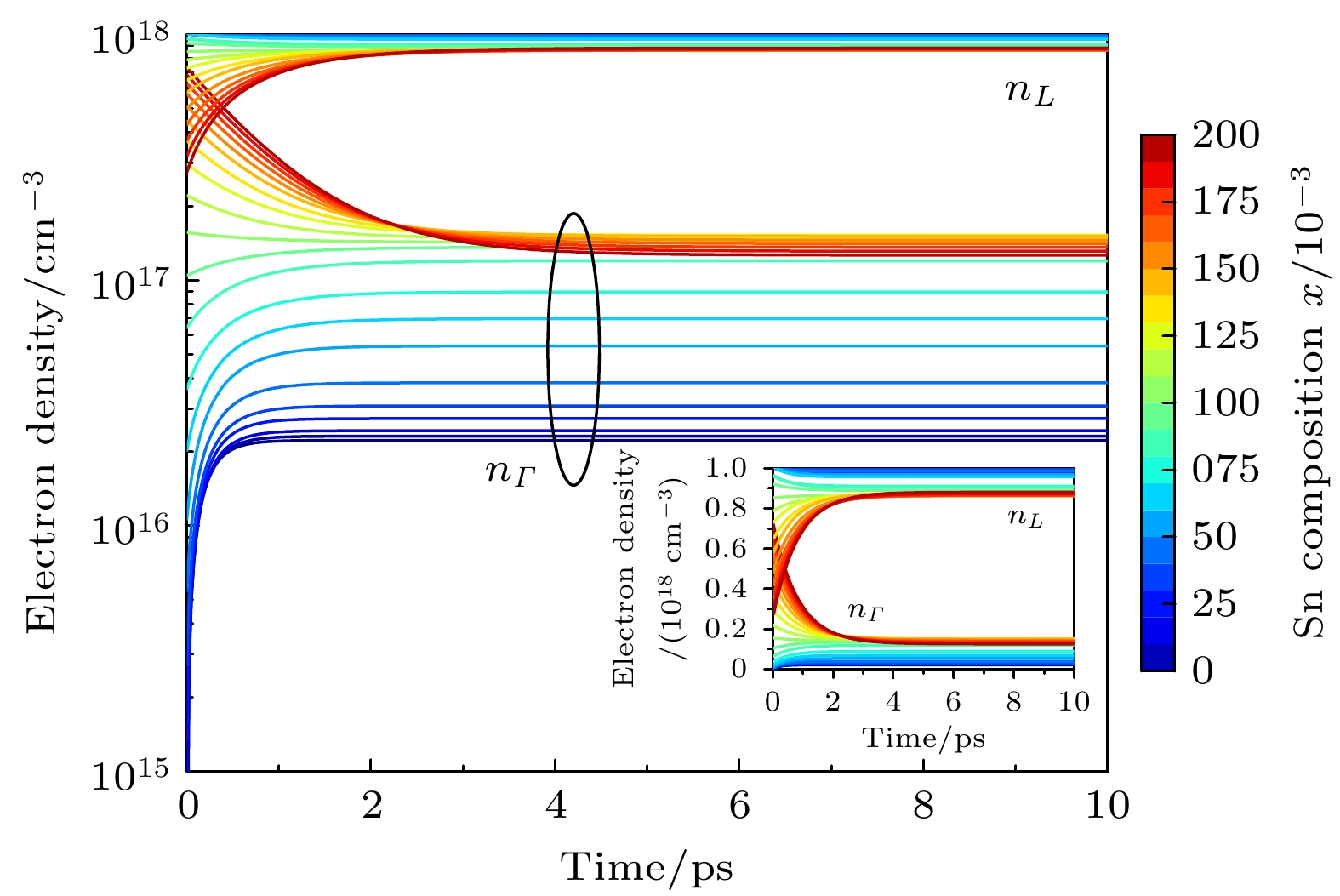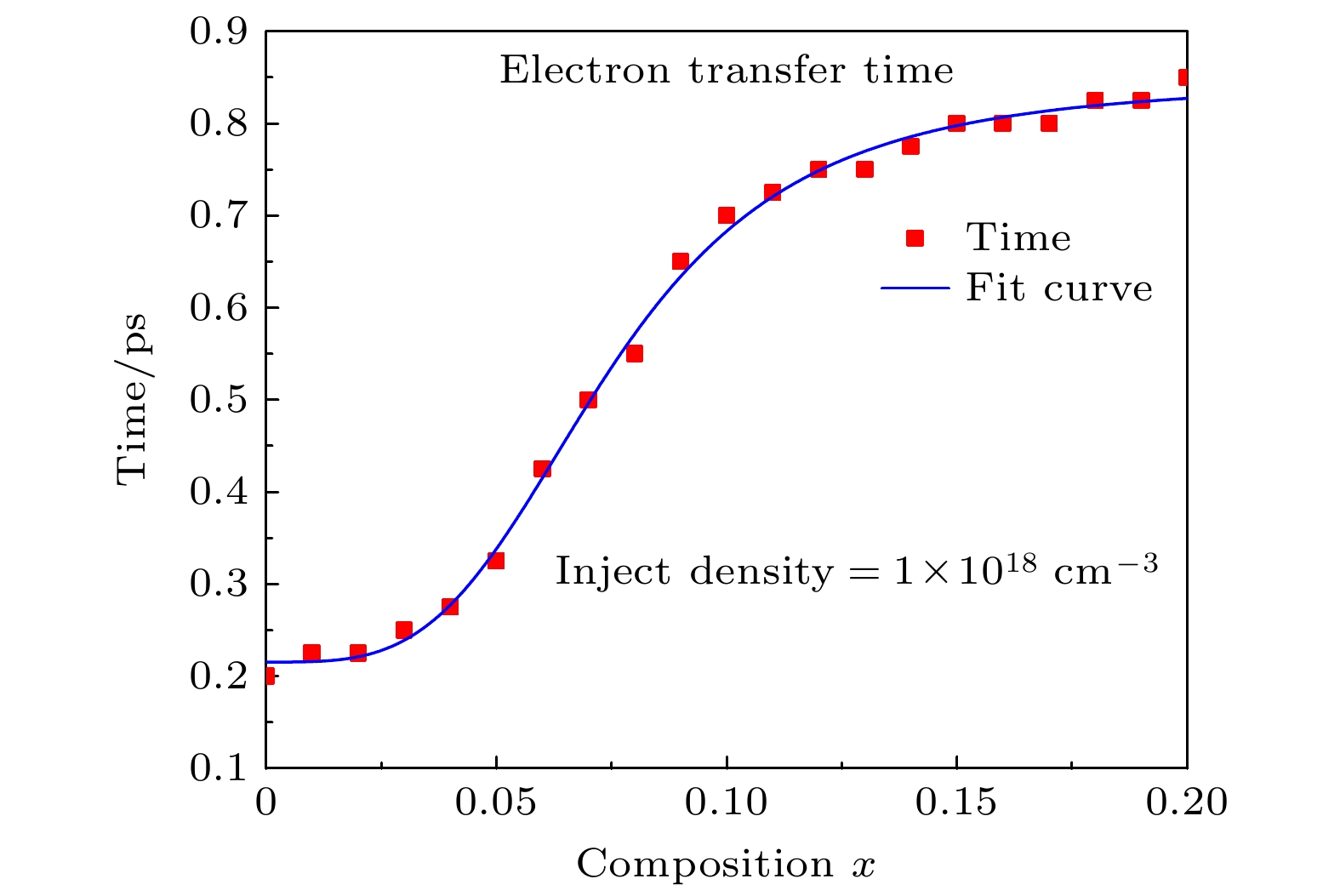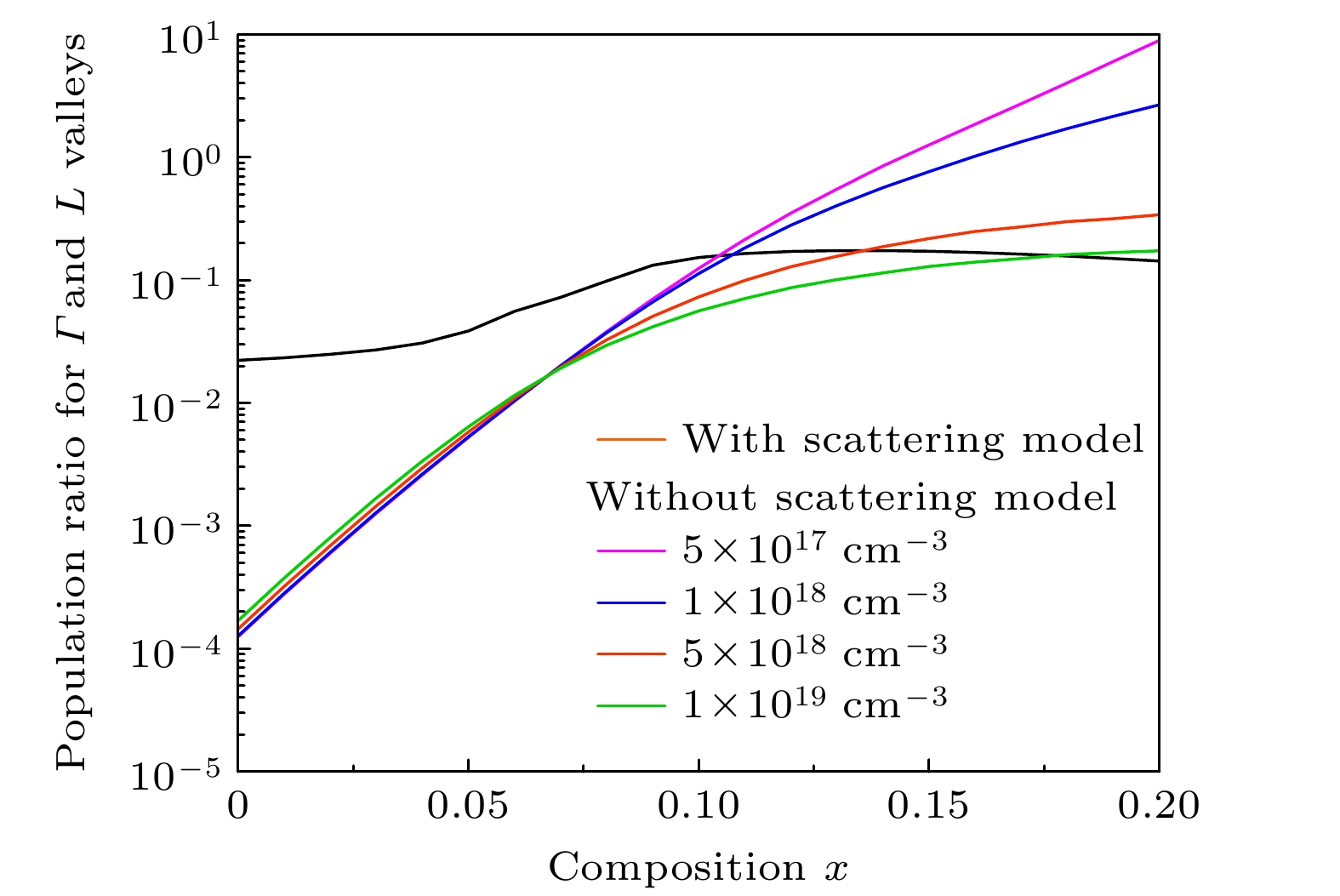-
Ge1–x Snx alloys have aroused great interest in silicon photonics because of their compatiblity with complementary metal-oxide-semiconductor (CMOS) technology. As a result, they are considered potential candidate materials. Owing to the significant differences in effective mass within the valleys, the unique dual-valley structure of Γ valley and L valley in energy can improve the optoelectronic properties of Ge1–x Snx alloys. Therefore, inter-valley scattering mechanisms between the Γ and L valley in Ge1–x Snx alloys are crucial for understanding the electronic transports and optical properties of Ge1–x Snx materials. This work focuses on the theoretical analysis of inter-valley scattering mechanisms between Γ and L valley, and hence on the electron transmission dynamics in Ge1–x Snx alloys based on the phenomenological theory model. Firstly, the 30th-order k ·p perturbation theory is introduced to reproduce the band structure of Ge1–x Snx. The results show that the effective mass of L valley is always about an order of magnitude higher than that of Γ valley, which will significantly influence the electron distributions between Γ and L valley. Secondly, the scattering mechanism is modeled in Ge1–x Snx alloys. The results indicate that scattering rate RΓL is about an order of magnitude higher than RLΓ, while RΓL decreases with the increase of Sn composition and tends to saturate when Sn component is greater than 0.1. And RLΓ is almost independent of the Sn component. Thirdly, kinetic processes of carriers between Γ and L valley are proposed to analyze the electron transmission dynamics in Ge1–x Snx alloys. Numerical results indicate that the electron population ratio for Γ-valley increases and then tends to saturation with the increase of Sn composition, and is independent of the injected electron concentration. The model without the scattering mechanism indicates that the electron population ratio for Γ-valley in indirect-Ge1–x Snx alloys is independent of the injected electron concentration, while the electron population ratio for Γ-valley in direct-Ge1–x Snx alloys is dependent on the injected electron concentration, and the lower the electron concentration, the greater the electron population ratio for Γ-valley is. The results open a new way of understanding the mechanisms of electron mobility, electrical transport, and photoelectric conversion in Ge1–x Snx alloys, and can provide theoretical value for designing Ge1–x Snx alloys in the fields of microelectronics and optoelectronics. [1] Miao Y H, Wang G L, Kong Z Z, Xu B Q, Zhao X W, Luo X, Lin H X, Dong Y, Lu B, Dong L P, Zhou J R, Liu J B, Radamson H H 2021 Nanomaterials 11 2556
 Google Scholar
Google Scholar
[2] Oka H, Mizubayashi W, Ishikawa Y, Uchida N, Mori T, Endo K 2021 Appl. Phys. Express 14 096501
 Google Scholar
Google Scholar
[3] Zhang D, Song J J, Xue X X, Zhang S Q 2022 Chin. Phys. B 31 068401
 Google Scholar
Google Scholar
[4] Wang H J, Han G Q, Jiang X W, Liu Y, Zhang J C, Hao Y 2019 IEEE Trans. Electron Devices 66 1985
 Google Scholar
Google Scholar
[5] Wang P C, Huang P R, Ghosh S, Bansal R, Jheng Y T, Lee K C, Cheng H H, Chang G E 2024 ACS Photonics 11 2659
 Google Scholar
Google Scholar
[6] Reboud V, Concepción O, Du W, El Kurdi M, Hartmann J M, Ikonic Z, Assali S, Pauc N, Calvo V, Cardoux C, Kroemer E, Coudurier N, Rodriguez P, Yu S Q, Buca D, Chelnokov A 2024 Photon. Nanostruc. Fundam. Appl. 58 101233
 Google Scholar
Google Scholar
[7] Zheng J, Liu Z, Xue C L, Li C B, Zuo Y H, Cheng B W, Wang Q M 2018 J. Semicond. 39 061006
 Google Scholar
Google Scholar
[8] Zhou Y Y, Dou W, Du W, Pham T, Ghetmiri S A, Al-Kabi S, Mosleh A, Alher M, Margetis J, Tolle J, Sun G, Soref R, Li B, Mortazavi M, Naseem H, Yu S Q 2016 J. Appl. Phys. 120 023102
 Google Scholar
Google Scholar
[9] Ghetmiri S A, Du W, Margetis J, Mosleh A, Cousar L, Conley B R, Domulevicz L, Nazzal A, Sun G, Soref R A, Tolle J, Li B, Naseem H A, Yu S Q 2014 Appl. Phys. Lett. 105 151109
 Google Scholar
Google Scholar
[10] Wirths S, Geiger R, von den Driesch N, Mussler G, Stoica T, Mantl S, Ikonic Z, Luysberg M, Chiussi S, Hartmann J M, Sigg H, Faist J, Buca D, Grützmacher D 2015 Nat. Photonics 9 88
 Google Scholar
Google Scholar
[11] Arakawa Y, Nakamura T, Urino Y, Fujita T 2013 IEEE Commun. Mag. 51 72
 Google Scholar
Google Scholar
[12] Wu S T, Zhang L, Wan R Q, Zhou H, Lee K H, Chen Q M, Huang Y C, Gong X, Tan C S 2023 Photonics Res. 11 1606
 Google Scholar
Google Scholar
[13] Liu X Q, Zhang J, Niu C Q, Liu T R, Huang Q X, Li M M, Zhang D D, Pang Y Q, Liu Z, Zuo Y H, Cheng B W 2022 Photonics Res. 10 1567
 Google Scholar
Google Scholar
[14] Ghosh S, Sun G, Yu S Q, Chang G E 2025 IEEE J. Sel. Top. Quantum Electron. 31 1
 Google Scholar
Google Scholar
[15] 黄诗浩, 谢文明, 汪涵聪, 林光杨, 王佳琪, 黄巍, 李成 2018 67 040501
 Google Scholar
Google Scholar
Huang S H, Xie W M, Wang H C, Lin G Y, Wang J Q, Huang W, Li C 2018 Acta Phys. Sin. 67 040501
 Google Scholar
Google Scholar
[16] Huang S H, Zheng Q Q, Xie W M, Lin J Y, Huang W, Li C, Qi D F 2018 J. Phys. Condens. Matter 30 465701
 Google Scholar
Google Scholar
[17] Murphy-Armando F, Murray É D, Savić I, Trigo M, Reis D A, Fahy S 2023 Appl. Phys. Lett. 122 012202
 Google Scholar
Google Scholar
[18] Wang C, Wang H, Chen W, Xie X, Zong J, Liu L, Jin S, Zhang Y, Yu F, Meng Q, Tian Q, Wang L, Ren W, Li F, Zhang H, Zhang Y 2021 Nano Lett. 21 8258
 Google Scholar
Google Scholar
[19] Stern M J, René de Cotret L P, Otto M R, Chatelain R P, Boisvert J P, Sutton M, Siwick B J 2018 Phys. Rev. B 97 165416
 Google Scholar
Google Scholar
[20] Huang P, Zhang Y, Hu K, Qi J, Zhang D, Cheng L 2024 Chin. Phys. B 33 017201
 Google Scholar
Google Scholar
[21] Rogowicz E, Kopaczek J, Kutrowska-Girzycka J, Myronov M, Kudrawiec R, Syperek M 2021 ACS Appl. Electron. Mater. 3 344
 Google Scholar
Google Scholar
[22] Rideau D, Feraille M, Ciampolini L, Minondo M, Tavernier C, Jaouen H, Ghetti A 2006 Phys. Rev. B 74 195208
 Google Scholar
Google Scholar
[23] Song Z, Fan W, Tan C S, Wang Q, Nam D, Zhang D H, Sun G 2019 New J. Phys. 21 073037
 Google Scholar
Google Scholar
[24] Lever L, Ikonić Z, Valavanis A, Kelsall R W, Myronov M, Leadley D R, Hu Y, Owens N, Gardes F Y, Reed G T 2012 J. Appl. Phys. 112 123105
 Google Scholar
Google Scholar
[25] Liu S Q, Yen S T 2019 J. Appl. Phys. 125 245701
 Google Scholar
Google Scholar
[26] Wang X, Li H, Camacho-Aguilera R, Cai Y, Kimerling L C, Michel J, Liu J 2013 Opt. Lett. 38 652
 Google Scholar
Google Scholar
[27] Claussen S A, Tasyurek E, Roth J E, Miller D A B 2010 Opt. Express 18 25596
 Google Scholar
Google Scholar
[28] Zhou X Q, van Driel H M, Mak G 1994 Phys. Rev. B 50 5226
 Google Scholar
Google Scholar
[29] Mak G, van Driel H M 1994 Phys. Rev. B 49 16817
 Google Scholar
Google Scholar
-
-
[1] Miao Y H, Wang G L, Kong Z Z, Xu B Q, Zhao X W, Luo X, Lin H X, Dong Y, Lu B, Dong L P, Zhou J R, Liu J B, Radamson H H 2021 Nanomaterials 11 2556
 Google Scholar
Google Scholar
[2] Oka H, Mizubayashi W, Ishikawa Y, Uchida N, Mori T, Endo K 2021 Appl. Phys. Express 14 096501
 Google Scholar
Google Scholar
[3] Zhang D, Song J J, Xue X X, Zhang S Q 2022 Chin. Phys. B 31 068401
 Google Scholar
Google Scholar
[4] Wang H J, Han G Q, Jiang X W, Liu Y, Zhang J C, Hao Y 2019 IEEE Trans. Electron Devices 66 1985
 Google Scholar
Google Scholar
[5] Wang P C, Huang P R, Ghosh S, Bansal R, Jheng Y T, Lee K C, Cheng H H, Chang G E 2024 ACS Photonics 11 2659
 Google Scholar
Google Scholar
[6] Reboud V, Concepción O, Du W, El Kurdi M, Hartmann J M, Ikonic Z, Assali S, Pauc N, Calvo V, Cardoux C, Kroemer E, Coudurier N, Rodriguez P, Yu S Q, Buca D, Chelnokov A 2024 Photon. Nanostruc. Fundam. Appl. 58 101233
 Google Scholar
Google Scholar
[7] Zheng J, Liu Z, Xue C L, Li C B, Zuo Y H, Cheng B W, Wang Q M 2018 J. Semicond. 39 061006
 Google Scholar
Google Scholar
[8] Zhou Y Y, Dou W, Du W, Pham T, Ghetmiri S A, Al-Kabi S, Mosleh A, Alher M, Margetis J, Tolle J, Sun G, Soref R, Li B, Mortazavi M, Naseem H, Yu S Q 2016 J. Appl. Phys. 120 023102
 Google Scholar
Google Scholar
[9] Ghetmiri S A, Du W, Margetis J, Mosleh A, Cousar L, Conley B R, Domulevicz L, Nazzal A, Sun G, Soref R A, Tolle J, Li B, Naseem H A, Yu S Q 2014 Appl. Phys. Lett. 105 151109
 Google Scholar
Google Scholar
[10] Wirths S, Geiger R, von den Driesch N, Mussler G, Stoica T, Mantl S, Ikonic Z, Luysberg M, Chiussi S, Hartmann J M, Sigg H, Faist J, Buca D, Grützmacher D 2015 Nat. Photonics 9 88
 Google Scholar
Google Scholar
[11] Arakawa Y, Nakamura T, Urino Y, Fujita T 2013 IEEE Commun. Mag. 51 72
 Google Scholar
Google Scholar
[12] Wu S T, Zhang L, Wan R Q, Zhou H, Lee K H, Chen Q M, Huang Y C, Gong X, Tan C S 2023 Photonics Res. 11 1606
 Google Scholar
Google Scholar
[13] Liu X Q, Zhang J, Niu C Q, Liu T R, Huang Q X, Li M M, Zhang D D, Pang Y Q, Liu Z, Zuo Y H, Cheng B W 2022 Photonics Res. 10 1567
 Google Scholar
Google Scholar
[14] Ghosh S, Sun G, Yu S Q, Chang G E 2025 IEEE J. Sel. Top. Quantum Electron. 31 1
 Google Scholar
Google Scholar
[15] 黄诗浩, 谢文明, 汪涵聪, 林光杨, 王佳琪, 黄巍, 李成 2018 67 040501
 Google Scholar
Google Scholar
Huang S H, Xie W M, Wang H C, Lin G Y, Wang J Q, Huang W, Li C 2018 Acta Phys. Sin. 67 040501
 Google Scholar
Google Scholar
[16] Huang S H, Zheng Q Q, Xie W M, Lin J Y, Huang W, Li C, Qi D F 2018 J. Phys. Condens. Matter 30 465701
 Google Scholar
Google Scholar
[17] Murphy-Armando F, Murray É D, Savić I, Trigo M, Reis D A, Fahy S 2023 Appl. Phys. Lett. 122 012202
 Google Scholar
Google Scholar
[18] Wang C, Wang H, Chen W, Xie X, Zong J, Liu L, Jin S, Zhang Y, Yu F, Meng Q, Tian Q, Wang L, Ren W, Li F, Zhang H, Zhang Y 2021 Nano Lett. 21 8258
 Google Scholar
Google Scholar
[19] Stern M J, René de Cotret L P, Otto M R, Chatelain R P, Boisvert J P, Sutton M, Siwick B J 2018 Phys. Rev. B 97 165416
 Google Scholar
Google Scholar
[20] Huang P, Zhang Y, Hu K, Qi J, Zhang D, Cheng L 2024 Chin. Phys. B 33 017201
 Google Scholar
Google Scholar
[21] Rogowicz E, Kopaczek J, Kutrowska-Girzycka J, Myronov M, Kudrawiec R, Syperek M 2021 ACS Appl. Electron. Mater. 3 344
 Google Scholar
Google Scholar
[22] Rideau D, Feraille M, Ciampolini L, Minondo M, Tavernier C, Jaouen H, Ghetti A 2006 Phys. Rev. B 74 195208
 Google Scholar
Google Scholar
[23] Song Z, Fan W, Tan C S, Wang Q, Nam D, Zhang D H, Sun G 2019 New J. Phys. 21 073037
 Google Scholar
Google Scholar
[24] Lever L, Ikonić Z, Valavanis A, Kelsall R W, Myronov M, Leadley D R, Hu Y, Owens N, Gardes F Y, Reed G T 2012 J. Appl. Phys. 112 123105
 Google Scholar
Google Scholar
[25] Liu S Q, Yen S T 2019 J. Appl. Phys. 125 245701
 Google Scholar
Google Scholar
[26] Wang X, Li H, Camacho-Aguilera R, Cai Y, Kimerling L C, Michel J, Liu J 2013 Opt. Lett. 38 652
 Google Scholar
Google Scholar
[27] Claussen S A, Tasyurek E, Roth J E, Miller D A B 2010 Opt. Express 18 25596
 Google Scholar
Google Scholar
[28] Zhou X Q, van Driel H M, Mak G 1994 Phys. Rev. B 50 5226
 Google Scholar
Google Scholar
[29] Mak G, van Driel H M 1994 Phys. Rev. B 49 16817
 Google Scholar
Google Scholar
Catalog
Metrics
- Abstract views: 2805
- PDF Downloads: 69
- Cited By: 0















 DownLoad:
DownLoad:

